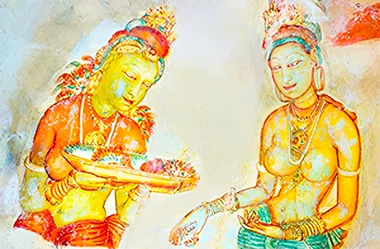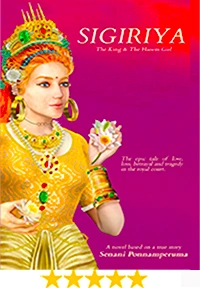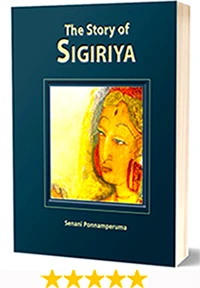Sigiriya and Kashyapa's Harem

Photo: Sigiriya harem ladies
Having lived in the king's harem we shall certainly not go outside in his absence.
Thus reflecting, they are as if stopped and are standing, looking forward.
Ancient Sigiriya Graffiti
Any reference today to the institution of the harem immediately conjures up in the western mind scantily clad young women forced into sexual slavery, solely for the gratification of a powerful man. This is a grossly distorted view of the institution, especially in Sri Lanka. The Arabic term "harem" conveys the notion of taboo and generally refers to prohibition. The Pali word "orodha" meaning "behind the curtain" implies a more sequestered existence. It usually referred to all the women of the royal household.
Polygamy was a deeply entrenched privilege of kingship. It was a social institution that was so much the norm that it gets scant mention in the Mahavamsa, the ancient chronicle of Sr Lankan history, or any other historic document.
A king such as Kashyapa of Sigiriya, had only one queen-wife who was, without exception, of royal or noble lineage. (The only exception was a lady by the name of Mahamatta). In addition to the single officially designated queen-wife, kings maintained a number of lesser wives and concubines. Being an expensive extravagance to upkeep, the number of women in the king's household was seen as a measure of his wealth, power and influence.
The orodha, or the harem, played an important role in society. Other than royal relatives, membership in the orodha was temporary. The pool of women in the royal harem was continuously refreshed. Young princesses and girls of noble birth joined the orodha to cement relationships between the king and local and foreign rulers. New entrants were chosen for their youth, beauty or social connections. Women from all walks of life could be selected for service in the harem. These ranged from princesses from foreign countries, daughters of chieftains and high class families, girls from lower socioeconomic standing offered by their families in the hope of improving their lot, "slave girls" gifted from foreign rulers and others selected for their beauty. There is no evidence of direct cohesion or kidnapping. Being a member of the king's harem was a badge of honor bringing prestige to her and to her family. A woman's worth after service in the king's harem was greatly increased allowing her to marry into the elite families of society.
Lesser-wives, sisters, mothers, consorts, concubines and young children lived together in a familial environment in secluded quarters in a large compound. The entire staff of this compound was women. It was guarded by an elite army composed of woman warriors who often wore male uniforms and were armed with a full range of halberds, bows, spears and armor. At Sigiriya this compound was probably the central ramparted area in the still to be excavated eastern precinct.
Photo: Lady with tattoo on Sigiriya Fresco
All the females depicted on the Sigiriya Frescoes wear a dainty three-ringed tattoo around their necks (see photo). Given the overall lack of information about the harem it is hard to establish with certainty if the woman of the harem were tattooed. This lack of evidence doesn't preclude the fact that it may have been the case. This practice is known to have occurred elsewhere. Given the prestige attached to being a member of the orodha there is little reason to doubt that these ladies would have gladly worn their delicately etched tattoos with pride.
Tattooed females are only depicted in the Sigiriya Frescoes and nowhere else in Sri Lankan art.

